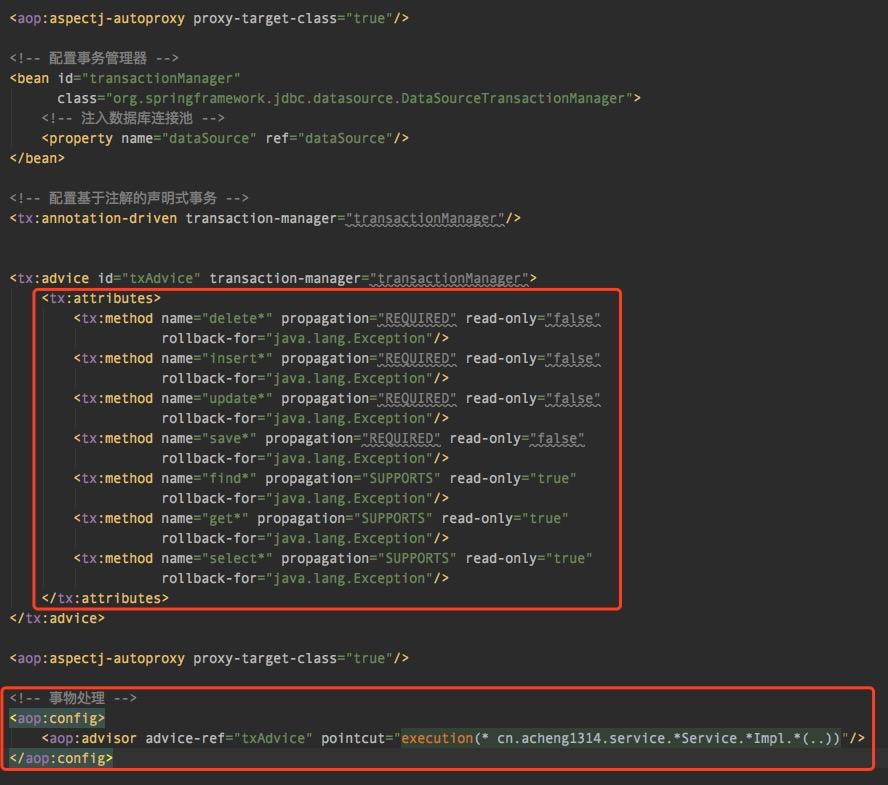SpringBoot2-第三章:springboot的事物控制
上一章我们简单的介绍了swagger相关的实现,毕竟我都是直接贴代码了,确实也是挺简单的,哈哈哈。 这一章我们主要介绍在springboot中的事物控制。
本项目的GitHub:https://github.com/pc859107393/Go2SpringBoot.git
有兴趣交流springboot进行快速开发的同学可以加一下下面的企鹅群。

回顾事物控制
在传统的Spring项目中,我们经典三层中主要在service层进行事物控制,常见的配置是什么呢?具体实现如图3.1所示。

图3.1 传统Spring项目的事物控制
在传统的Spring项目中,我们的事物控制需要考虑如下几点:
- 开启事务管理
- 区别只读事物和读写事物
- 配置Spring事物控制规则
- 找到service层的实现类
既然我们知道了传统的事物控制我们需要做的事情,理解了这一点,我们也就可以在springboot项目中推测我们需要哪些东西。 ①. 事物控制相关依赖资源 ②. 事物管理开启 ③.事物读写规则控制 ④.事物读写的实现.
在前面我们构建项目的时候已经加入了 spring-boot-starter-aop ,所以依赖资源不是问题。接着我们需要编写代码来实现相关的规则、开启事物和实现事物。
首先我们可以上网查询一下springboot相关的事物,无外乎都是懒人办法直接在service方法上面添加注解 @Transactional 和在入口类上面使用 @EnableTransactionManagement ,这样就能在项目中指定的方法上面开启事物了。
但是有没有一种更懒得方式呢?一定是有的,估计也是和Spring项目中类似。我们检验的标准是什么?肯定是在service对应的方法内发生异常引起回滚操作。其他的原理不必解释太多,先上码。
@SpringBootApplication
@EnableWebMvc
@EnableSwagger2
@MapperScan(value = ["cn.acheng1314.base.dao"])
@Configuration
@EnableTransactionManagement
class BaseApplication : WebMvcConfigurer {
//事物类型参数
fun transactionAttributeSource(): TransactionAttributeSource {
val source = NameMatchTransactionAttributeSource()
//只读或可写事物
val readOnlyTx = RuleBasedTransactionAttribute()
readOnlyTx.isReadOnly = true
readOnlyTx.propagationBehavior = TransactionDefinition.PROPAGATION_SUPPORTS
//可写事物
val requiredTx = RuleBasedTransactionAttribute(TransactionDefinition.PROPAGATION_REQUIRED
, Collections.singletonList(RollbackRuleAttribute(Exception::class.java)))
val txMap = HashMap<String, TransactionAttribute>()
txMap["add*"] = requiredTx
txMap["save*"] = requiredTx
txMap["insert*"] = requiredTx
txMap["update*"] = requiredTx
txMap["delete*"] = requiredTx
txMap["get*"] = readOnlyTx
txMap["query*"] = readOnlyTx
txMap["find*"] = readOnlyTx
source.setNameMap(txMap)
return source
}
/*事务拦截器*/
@Bean(value = ["txInterceptor"])
fun getTransactionInterceptor(tx: PlatformTransactionManager): TransactionInterceptor {
return TransactionInterceptor(tx, transactionAttributeSource())
}
/**切面拦截规则 参数会自动从容器中注入 */
@Bean
fun pointcutAdvisor(txInterceptor: TransactionInterceptor): AspectJExpressionPointcutAdvisor {
val pointcutAdvisor = AspectJExpressionPointcutAdvisor()
pointcutAdvisor.advice = txInterceptor
pointcutAdvisor.expression = "execution (* cn.acheng1314.base.service.*ServiceImpl.*(..))"
return pointcutAdvisor
}
//省略其他代码
}
在上面的事物规则参数中我们设置了两边倒事物(readOnlyTx,使用了 TransactionDefinition.PROPAGATION_SUPPORTS 设置为两边倒事物)和可写入事物(requiredTx)。接着我们在UserServiceImpl中写一个发生异常的方法,测试是否能够产生事物回滚,代码片段如下:
// @Transactional
@Throws(Exception::class)
fun addUser() {
val user = User()
user.duty = "aaa"
user.loginName = "aaa"
user.name = "aaa"
user.password = "aaa"
user.createDate = Date()
baseMapper.insert(user)
throw Exception("测试事物")
}
我们来一点点代码进行单元测试,如下:
@RunWith(SpringJUnit4ClassRunner::class)
@SpringBootTest(classes = [BaseApplication::class])
class UserServiceImplTest {
@Autowired
private lateinit var userService: UserServiceImpl
@Test
fun addUserTest() {
userService.addUser()
}
}
最后运行测试代码后,我们可以发现在数据库中并没有aaa这个用户信息存在,所以我们事物控制成功了。具体效果不用上图了,大家都能在各自的数据库工具中看到。











![[HBLOG]公众号](https://www.liuhaihua.cn/img/qrcode_gzh.jpg)

